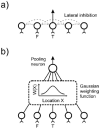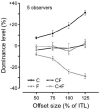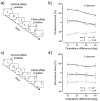Feature integration across space, time, and orientation
- PMID: 19968428
- PMCID: PMC3277857
- DOI: 10.1037/a0015798
Feature integration across space, time, and orientation
Abstract
The perception of a visual target can be strongly influenced by flanking stimuli. In static displays, performance on the target improves when the distance to the flanking elements increases-presumably because feature pooling and integration vanishes with distance. Here, we studied feature integration with dynamic stimuli. We show that features of single elements presented within a continuous motion stream are integrated largely independent of spatial distance (and orientation). Hence, space-based models of feature integration cannot be extended to dynamic stimuli. We suggest that feature integration is guided by perceptual grouping operations that maintain the identity of perceptual objects over space and time.
Figures









References
-
- Appelle S. Perception and discrimination as a function of stimulus orientation: the “oblique effect” in man and animals. Psychological Bulletin. 1972;78(4):266–278. - PubMed
-
- Ariely D. Seeing sets: representation by statistical properties. Psychological Science. 2001;12(2):157–162. - PubMed
-
- Aydin M, Herzog MH, Ogmen H. Compression in slit viewing occurs at an object level. 2008 In revision. - PubMed
-
- Bach M. The Freiburg visual acuity test - automatic measurement of visual acuity. Optometry and Vision Science. 1996;73(1):49–53. - PubMed
-
- Badcock DR, Westheimer G. Spatial location and hyperacuity: flank position within the centre and surround zones. Spatial Vision. 1985a;1(1):3–11. - PubMed

